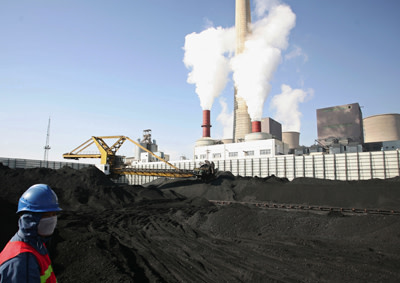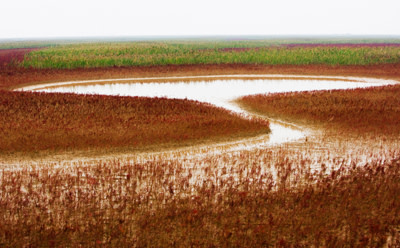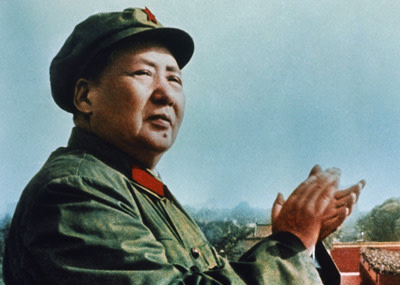The fight for ‘China’s sorrow’
Roula Khalaf, Editor of the FT, selects her favourite stories in this weekly newsletter.
Zhang Baishan has one of the toughest jobs in China. Mr Zhang wears the uniform of the Chinese bureaucrat – black loafers, black trousers, black windbreaker – but he does more than push papers. The 56-year-old is in charge of making sure that the provinces along China’s most important river stick to an agreement to share its water, a task that is growing harder as the country’s industrial growth outpaces its resources.
In his efforts to control the Yellow River Mr Zhang is heir to a mythical engineer called Yu the Great, who first tamed the river 4,000 years ago. But while Yu laboured to manage floods, Mr Zhang’s challenge as director of water resources management at the Yellow River Conservancy Commission is to keep the world’s sixth-longest river from running dry.
For centuries the Chinese heartland has depended on the muddy Yellow River, nicknamed “China’s sorrow” because of its tendency to flood. Starting on the Tibetan plateau, it loops through the coal-rich deserts of Ningxia and Inner Mongolia before crossing the north China plain to the Shandong coast. It stretches more than 5,400km, almost as long as the Mississippi and Missouri rivers.
As China’s economy has boomed, the burden on the river has grown: heavy industry, water-intensive agriculture and the pressures of urbanisation have all taken a toll. Growing cities require more power, which means burning more coal. City dwellers use five times more water than their rural cousins.
The demands on the river grew too great in 1997 when, for eight long months, it failed to reach the Yellow Sea. That forced squabbling provinces to strike a political deal that has kept the river flowing for the past 17 years.
That agreement is now fraying as new industries in the northwest place greater pressure on the river. But “no one wants to budge”, says Mr Zhang, sitting in his office in the ancient Chinese capital of Zhengzhou. “They know the pie is getting smaller.”
So the commission is trying something else: economic incentives to keep demand in check and prevent a dangerous upstream water grab. The idea is that new industrial users pay to displace traditional farmers, keeping total water demand in check.
There are other rivers around the world that no longer reach the sea, including the powerful Colorado that flows through the US southwest into northwest Mexico. But Beijing cannot afford to let that happen to the Yellow River, which supports one in every 12 Chinese, or about 100m people.
FT series

An investigation into how businesses are having to adapt to rising water costs around the world
Mindful that rural rebellions have toppled dynasties since Yu’s day, China’s Communist party cannot simply cut off the farmers who still account for 70 per cent of water use. Nor can it deprive gleaming new cities of drinking water.
The commission’s solution is to make new industrial users pay for improved irrigation to keep water use within the bounds of what the river can support. Similar schemes could someday manage demand across China so that competition for water does not cause economic growth to founder.
“The only thing that can stop the China story is water,” says Michael Komesaroff of industrial consultancy Urandaline Investments.
Zhengzhou: control centre
Yu’s image is carved like a guardian saint on the entrance gates of the commission in Zhengzhou, a city founded when the engineer roamed the riverbanks. On the ground floor, a control room monitors dams and discharge pipes along the river. From here the water is doled out to factories and farms under the watchful eye of Mr Zhang.
He is lobbied year round by representatives from 11 provinces and regions who want more water. Delegations fly to Zhengzhou to beg for permission to deviate from the plan. Some appeal to the central government if they are turned down.
“There is no way I can please every province,” admits Mr Zhang.
The provinces first divvied up the rights in 1987 to make sure upstream provinces such as Inner Mongolia did not take all the water. But that deal did not account for yearly fluctuations so every province exhausted its quota in the 1997 drought. The river was dry for 226 days.
That crisis focused minds. But as water demand rises across China, there is little consensus on a lasting political solution. So the commission is trying economic incentives.
On paper the commission’s power is absolute. Yearly quotas are set at a winter meeting of provincial water bureaus, in the tradition of the planned economy. Because neither rivers nor human consumption conform to annual plans, the commission adjusts allocations every 10 days or so. But in practice its power is limited: it cannot veto dams, even though 74 clog the river.
And it has little influence over the nation’s development agenda. China’s growth-oriented political system encourages industrial development on the north China plain, despite there being little water to spare. With river use capped, farmers and cities drill into aquifers, causing the water table to drop by several feet each year.
“China is bumping up against scarcity on a national scale,” says environmental economist Leo Horn-Phathanothai, co-author of Climate Change and Development. “The Yellow River is a microcosm of this.”
The commission has kept the river flowing but has not succeeded in limiting pollution. Only about half the river meets national standards and some tributaries are so polluted they are unsuitable for human contact.
In 2012 China said its estimated water reserves were lower than previously thought. The annual usable supply in the Yellow River was cut to 34bn cubic metres from 37bcm in 1987, after subtracting water needed to flush out sediment. In the past 14 years, actual usable levels fluctuated between 37bcm and 24bcm.
But demand for water from the Yellow River keeps rising, especially in the oases of northwest China where there is abundant coal and almost no rain – places like Ningxia.
Ningxia: boom time
The coal fields of Ningxia begin as soon as National Highway 20 leaves the green fields of the Yellow River valley for the flat, dusty expanses of the Ordos desert. Power plants and petrochemical refineries flash by one after the other as the horizon vanishes into a thin haze.
It is boom time in Ningxia, a region smaller than Ireland tucked into the southern flank of the Gobi desert.

For 2,000 years, the man-made estuary where the Yellow River spills on to the plain has supported an emerald triangle of rice paddies and wetlands, hemmed in by yellow desert and the crumbling ruins of the Great Wall.
Millennia ago Yellow River swamps formed the huge coal beds of Ningxia and neighbouring Inner Mongolia.
Today, coal mines and farms compete for water in the green swaths where the river cuts through the Gobi. Ningxia, home to 6.5m people, plans to produce 120m tonnes of coal next year, enough to power Greater London for 19 years.
When the provinces hammered out their agreement on sharing the river, Ningxia’s economy was still small. Its 7 per cent quota is not enough for its agricultural needs today, let alone its plans to produce power, chemicals and fuel. Arid Inner Mongolia has also surpassed its quota, experts say.
So the commission has devised a scheme to transfer water rights within those regions. New industrial users pay millions of renminbi to the Ningxia Water Bureau for water rights. The money funds projects such as lining irrigation channels with concrete to stem seepage.
“The commission told us it’s impossible to allocate additional water for our industrial development, so where can the water come from? It has to be saved from agriculture,” says Si Jitiao, the Oklahoma-educated engineer trying to attract investors to Ningxia’s state-run industrial park.
The scheme puts a market value on water, forcing industry and agriculture to be more efficient. For decades the state kept water prices low to avoid rural unrest, resulting in little incentive to conserve water.
Since the scheme began, the transfer price has doubled to nearly Rmb25 ($4) per cubic metre, and total water use has stayed stable.
“We are relatively satisfied,” says Mr Zhang.
In the villages of the green delta, farmers have stopped growing rice as water prices rise. “This year the government was adamant. No one should plant rice at all,” says one farmer who now plants flowers. “It’s a water crisis.”
In many irrigation canals supply has dropped sharply. Some villages are drilling into aquifers.
“Inner Mongolia needs the water,” says a farmer wearing a jacket labelled “US Army” and tending to an unfamiliar crop of ornamental trees. He is not complaining. Flowers and trees sell for more than rice.
Faced with high water fees, the power plants and refineries of Ningxia are some of the most water-efficient in the world – an example for the rest of China. But limiting farmers’ access to water could hurt China’s food security. And the scheme does little to address the problems of water pollution and aquifer depletion.
The pilot is about to grow broader. Downriver, Inner Mongolia’s coal boomtown Ordos is looking to transfer rights so local coal group Shenhua can tap more river water.
Dongying: thirsty oil town
In the estuary town of Dongying, Shengli, China’s second-largest oil field, sits at the mouth of the Yellow River. It has the most to lose from an upstream water grab.

China imports half its oil. Energy security is one of the reasons for developing desert coal fields, despite the strain on fragile oases. That also means it is essential that the river flows to sustain the Shengli field.
Dongying shows China can improve water efficiency when it must. The 1997 crisis scared state oil company Sinopec into finding ways to reduce river water use. At the time, engineers pumped fresh river water under ground to maintain oil pressure and output. “We realised that was a waste,” says Li Zhenquan, Shengli’s director of enhanced oil recovery.
Sinopec’s water use at Shengli has halved from its 1997 peak. The company has invested millions of dollars into treating polluted Yellow river water so that it is usable in its refineries and drinkable in Dongying. Sinopec is also an investor in Ningxia’s coal projects, making it a powerful advocate for industrial water use along the river.
With more muscle and money behind industry, even one that uses water efficiently, China’s agriculture will have to give ground, as it is doing in Ningxia and Dongying.
Former rice farmers in the Yellow river estuary now raise goats or cotton but still fight over water, one local farmer says.
“We didn’t have enough water this year, so villagers closed the irrigation gates and cut off the next village,” the farmer says.
If Mr Zhang’s scheme works, it will prevent skirmishes like these from turning into devastating water wars.
Additional reporting by Owen Guo
Mao philosophy converted to water reality
China’s most ambitious solution to water scarcity in Northern China is to add another Yellow River, writes Lucy Hornby in Beijing.
Builders are putting the finishing touches to the central phase of one of the world’s biggest, most expensive and most controversial engineering projects. The south-north water diversion project will re-route nearly 32bn cubic metres a year away from the mighty Yangtze River to boost supply to Beijing and the industrialised North China plain. That is nearly the same as the usable water in the Yellow River.

The idea is rooted in a remark by Mao Zedong: “Southern water is plentiful, northern water scarce. If at all possible, borrowing some water would be good.”
As Beijing prepares for the arrival of the autumn rains, a number of proposals are being drawn up for water-intensive projects in northern China. “The first response to shortage is always supply. Don’t tackle the issue of who gets what; just grow the pie by borrowing from the south,” says environmental economist Leo Horn-Pathanothai.
The $60bn middle route involves enlarging a reservoir on the Han river, a Yangtze tributary, to transport up to 13bcm of water a year across 1,200km of canals and tunnels. About 330,000 people are being displaced by the flooded reservoir. Officials in Yangtze River provinces worry the decreased flow will increase pollution and hurt the delta cities, including Shanghai.
The eastern route of the project, which involves pumping Yangtze River water up the 1,400-year-old Grand Canal, is complete.
Most controversial is a plan to drill three tunnels through hundreds of miles of hard rock to connect the three tributaries of the Yangtze with the Yellow River near their source on the high Tibetan plateau. Environmentalists are firmly opposed to the idea. Politicians were so dubious many thought the idea had been shelved.
Support for the plan is growing again because of increased demand in the northwest. “There was a time when opinions were divided,” says, Zhang Baishan of the Yellow River Conservancy Commission, “Now, from an overall perspective, we believe it is beneficial.”
Comments